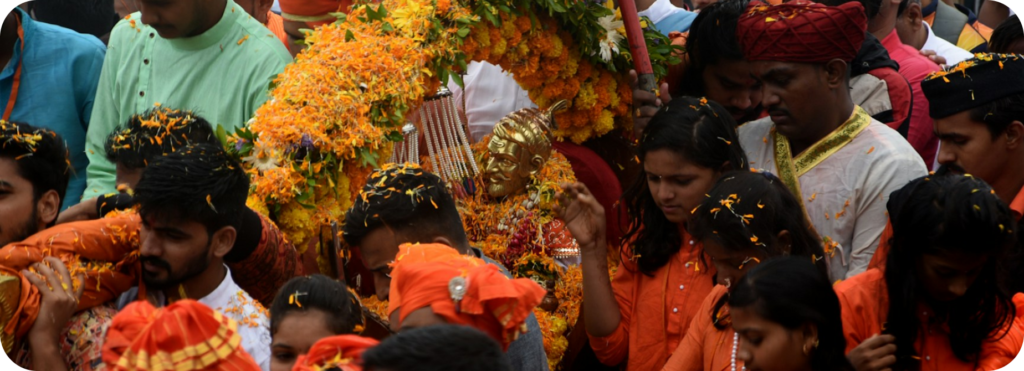About CKP Samaj
Chandraseniya Kayastha Prabhu (CKP) is a caste mainly found in Maharashtra, Madhya Pradesh & Gujarat. Historically, they made equally good warriors, statesmen as well as writers. Other than the Brahmins, the Prabhus (CKPs and Pathare Prabhus) were the communities advanced in education.
The CKPs have the upanayana ( janeu or thread ceremony) and have been granted the rights to study the Vedas and perform Vedic rituals along with the Brahmins. The CKP performed three Vedic karmas or duties which in Sanskrit are called:
- Adhyayan- studying of the Vedas
- Yajna- ritual done in front of a sacred fire, often with mantras
- Dāna – alms or charity.



Ritually ranked high (along with the Brahmins), the caste may be considered socially proximate to the Brahmin community. Numerically small, but they have traditionally been an elite and literate community.
The CKP claim descent from Chandrasen, an ancient Kshatriya king of Ujjain and Ayodhya and of the Haihaya family of the lunar Kshatriya Dynasty.
The name Chandraseniya may be a corruption of the word Chandrashreniya, which means from the valley of the Chenab River in Kashmir. This theory states that the word Kayastha originates from the term Kaya Desha, an ancient name for the region around Ayodhya. The word Prabhu means Lord or a Chief in Sanskrit language.
Epigraphical evidences or engravings from the Shilahara times have been found in Deccan to prove that many CKPs held high posts and controlled the civilian and military administration. A Shilahara inscription around A.D. 1088 mentions the names of a certain Velgi Prabhu, Lakshman Prabhu is mentioned as a Maha Dand Nayak (head of military) and Maha Pradhan (prime minister); Ananta-Prabhu is mentioned as a Maha Pradhan (prime minister), Koshadhikari (Head of treasury) and Maha sandhi vigrahika (charge of foreign department).
The CKP community became more prominent during the Deccan sultanates and Maratha rule era. During Adilshahi and Nizamshahi, CKP, the Brahmins and high-status Maratha were part of the elites.

Given their training CKP served both as civilian and military officers. Several of the Maratha Chhatrapati Shivaji’s generals and ministers, such as Murar baji Deshpande and Baji Prabhu Deshpande, and Khando Ballal Chitnis were CKPs.
In 17th-century Maharashtra, during Shivaji’s time, the so-called higher classes i.e. the Marathi Brahmins, CKPs and Saraswat Brahmins, due to social and religious restrictions were the only communities that had a system of education for males. Except these three castes, education for all other castes and communities was very limited and consisted of listening to stories from religious texts like the Puranas or to Kirtans and thus the common masses remained illiterate and backward. Hence Shivaji was compelled to use people from these three educated communities – Marathi Brahmins, CKPs and Saraswat Brahmins – for civilian posts as they required education and intellectual maturity.
However, in this time period, these three as well as other communities, depending on caste, also contributed their share to Shivaji’s “Swaraj”(self-rule) by being cavalry soldiers, commanders, mountaineers, seafarers etc.
As the Maratha empire/confederacy expanded in the 18th century, and given the nepotism of the Peshwa of Pune towards their own Chitpavan Brahmin caste, CKP and other literal castes migrated for administration jobs to the new Maratha ruling states such as the Bhosale of Nagpur, the Gaekwads, the Scindia, the Holkars etc., The Gaekwads of Baroda and the Bhosale of Nagpur gave preference to CKPs in their administration.
The CKPs, described as a traditionally well-educated and intellectual group claimed themselves as Kshatriyas.
During the British colonial era, the two literate communities of Maharashtra, namely the Brahmins and the CKP were the first to adopt western education with enthusiasm and prospered with opportunities in the colonial administration. A number of CKP families also served the semi-independent princely states in Maharashtra and other regions of India, such as Baroda.
In 1902, all communities other than Marathi Brahmins, Saraswat Brahmins, Prabhus (Chandraseniya Kayastha Prabhus, Pathare Prabhus) and Parsi were considered backward and 50% reservation was provided for them in by the princely state of Kolhapur.
In 1925, the only communities that were not considered backward by the British Government in the Bombay Presidency were Brahmins, CKP, Pathare Prabhus, Marwaris, Parsis, Banias and Christians.
Many CKP clans have Ekvira temple at Karla as their family deity whereas others worship Vinzai, Kadapkarin, Janani as their family deity.
CKPs have had a progressive attitude regarding female education compared to other communities.
